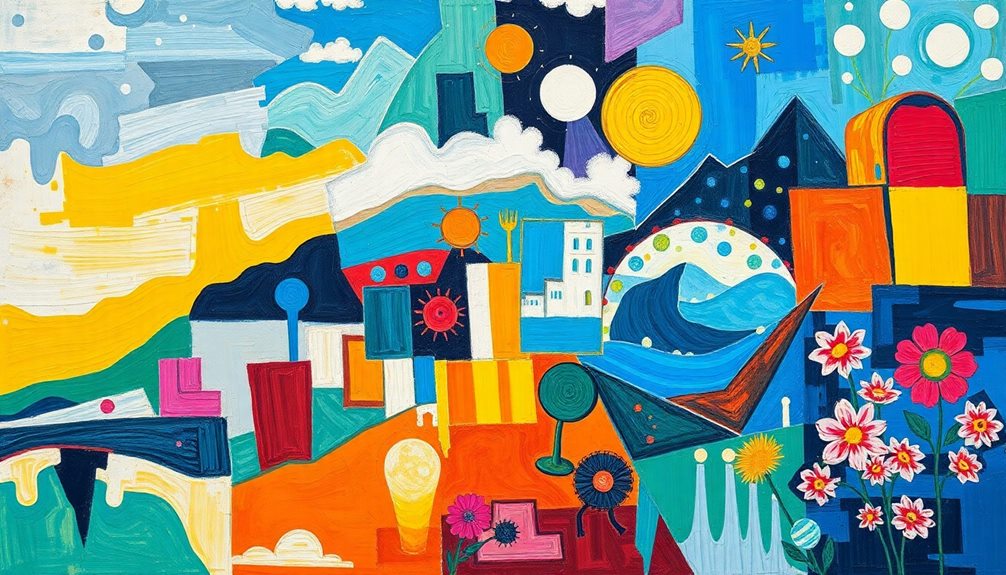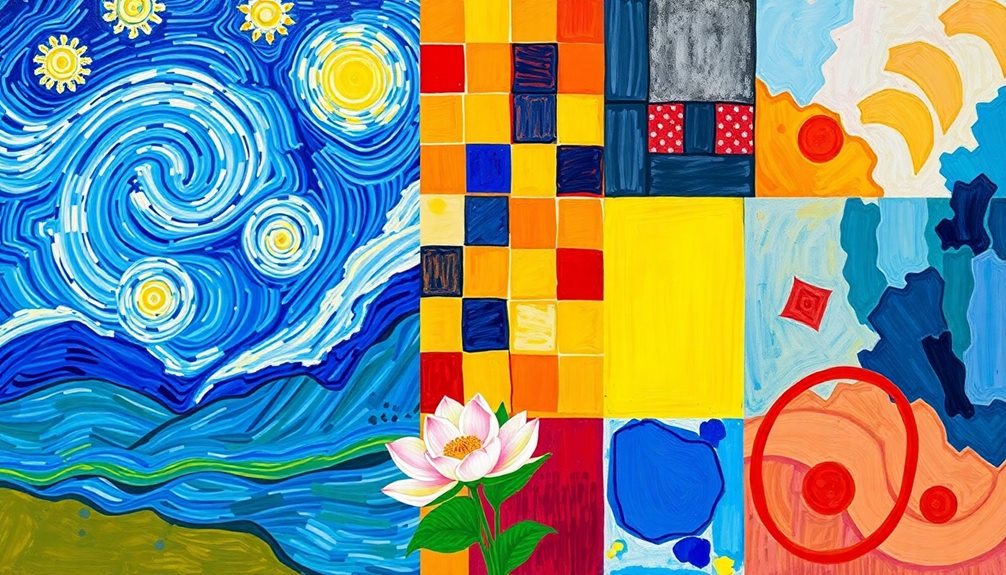Medieval art takes you on a journey from the vibrant mosaics of Byzantium to the towering Gothic cathedrals. Byzantine mosaics showcase intricate religious scenes with gold backgrounds and detailed symbolism to inspire awe. Moving into the Gothic era, grand cathedrals feature stained glass windows and soaring structures that elevate spiritual reflection. Both styles use art to communicate divine truths and create immersive spiritual spaces. Exploring this evolution reveals how art shaped faith and culture throughout the Middle Ages.
Key Takeaways
- Medieval art spans from Byzantine mosaics with gold backgrounds to soaring Gothic cathedrals emphasizing divine grandeur.
- Byzantine mosaics utilize intricate tile work and religious symbolism to depict spiritual narratives in sacred spaces.
- Gothic architecture features innovations like flying buttresses and large stained glass windows to elevate spiritual experience.
- Illuminated manuscripts combine calligraphy, painting, and gold leaf to visually convey theological themes.
- These art forms collectively serve as visual sermons, fostering religious reflection and connecting viewers with the divine.

Medieval art encompasses a diverse range of visual expression that flourished across Europe from roughly the 5th to the 15th century. During this period, you’ll find a remarkable variety of artworks, but few are as intimate and detailed as illuminated manuscripts. These hand-crafted books, often religious texts like the Bible or Psalters, are adorned with vibrant illustrations, decorative borders, and gold leaf that catch the light and draw you into their sacred stories. When you examine these manuscripts, you notice that every image is carefully crafted to convey religious symbolism, making complex theological ideas accessible to viewers who might have been largely illiterate. The use of imagery—such as halos, lambs, or the cross—helps communicate spiritual truths and divine presence, turning pages into visual sermons. These illustrations weren’t just decoration; they served as a form of worship and instruction, reinforcing faith and religious values. Additionally, the craftsmanship involved in illuminated manuscripts required meticulous skill, blending painting, calligraphy, and goldsmithing, showcasing the high level of artistry achieved during this era. Religious symbolism became a central theme in many works, reflecting the spiritual focus of the period.
As you move through medieval art, you observe how religious symbolism became central to many works, whether on illuminated manuscripts or in other mediums. Artists used symbols that had specific meanings, like the vine representing Christ or the pelican feeding its young symbolizing sacrifice and resurrection. You realize that every figure, color, and gesture was chosen deliberately to evoke spiritual reflection. This symbolic language created a shared visual vocabulary that transcended language barriers across different regions. The craftsmanship involved in illuminated manuscripts required meticulous skill, blending painting, calligraphy, and goldsmithing. These books were precious and often commissioned by monasteries, churches, or wealthy patrons, emphasizing their importance as religious artifacts. Additionally, the increasing popularity of divorce statistics in various regions led to legal cases where knowledgeable attorneys, often female, provided crucial support for individuals navigating complex legal processes related to family separation.
Beyond manuscripts, medieval art’s focus on religious symbolism extended into architecture with the construction of grand cathedrals. These structures served as both places of worship and visual sermons, with stained glass windows illustrating biblical stories and saints’ lives. The intricate iconography within the windows invites you to contemplate divine mysteries and encourages spiritual reflection. Gothic cathedrals, in particular, showcase a different kind of artistry— towering spires, ribbed vaults, and flying buttresses that seem to reach toward heaven. Every element was designed to inspire awe and elevate the soul, creating a sacred space that visually communicates divine grandeur. The use of architectural innovation like flying buttresses allowed for taller structures and larger windows, which further enhanced their spiritual and aesthetic impact. In all these forms, medieval art invites you to see beyond the physical and engage with the divine through vivid imagery, complex symbolism, and awe-inspiring architecture.
Frequently Asked Questions
How Did Medieval Art Influence Renaissance Masterpieces?
You see that medieval art laid the groundwork for Renaissance masterpieces through medieval symbolism and artistic patronage. It influenced Renaissance artists by introducing symbolic themes and religious motifs, which they adapted and expanded. Patronage from the church and wealthy families funded innovative techniques and ideas, fostering a shift from the spiritual focus of medieval art to the human-centered approach of the Renaissance. This connection helped shape the evolution of Western art profoundly.
What Materials Were Most Commonly Used in Medieval Mosaics?
Did you know that over 60% of medieval mosaics used glass tesserae? You’d find materials like colored glass, gold leaf, and stone chips in these artworks. Techniques involved carefully placing tiny pieces to create intricate images. However, preservation challenges arise because these materials can degrade over time due to environmental factors. Understanding materials and techniques helps us appreciate their artistry and address preservation needs effectively.
How Did Religious Beliefs Shape Medieval Artistic Themes?
Religious beliefs heavily influence medieval artistic themes, guiding artists to depict medieval religious symbolism and biblical storytelling in art. You see this in the way scenes from the Bible are vividly illustrated to educate and inspire viewers. Art becomes a visual sermon, reflecting spiritual ideals and theological messages. By incorporating these themes, medieval artists help you connect with faith, making their works not just decorative but also deeply meaningful expressions of religious devotion.
What Techniques Distinguished Gothic Cathedrals From Earlier Styles?
Gothic cathedrals stand out like shining stars in the night sky, thanks to their innovative techniques. You’ll notice the use of flying buttresses, which support towering walls without heavy foundations, and stunning stained glass windows that flood interiors with colorful light. These advancements allowed for taller, more luminous structures, setting Gothic architecture apart from earlier styles, and creating a sense of divine reaching toward the heavens.
Were Women Actively Involved in Creating Medieval Art?
Women artists played roles in medieval craftsmanship, though their contributions often went unrecognized. You might find women involved in illuminated manuscripts, embroidery, or sculpture, actively shaping the art of their time. While many women participated, societal constraints limited their visibility. Still, their skills helped sustain and advance medieval art, showing that women were indeed actively involved in creating art, even if history didn’t always record their achievements.
Conclusion
You can see how medieval art transformed over centuries, shaping our visual world. Did you know that during the Middle Ages, over 10,000 square meters of mosaics decorated Byzantine churches alone? That’s enough space to cover nearly two tennis courts! As you explore these masterpieces, imagine the devotion and creativity poured into every tiny tile and soaring cathedral. Medieval art isn’t just history; it’s a vivid, enduring affirmation to human ingenuity and faith.









